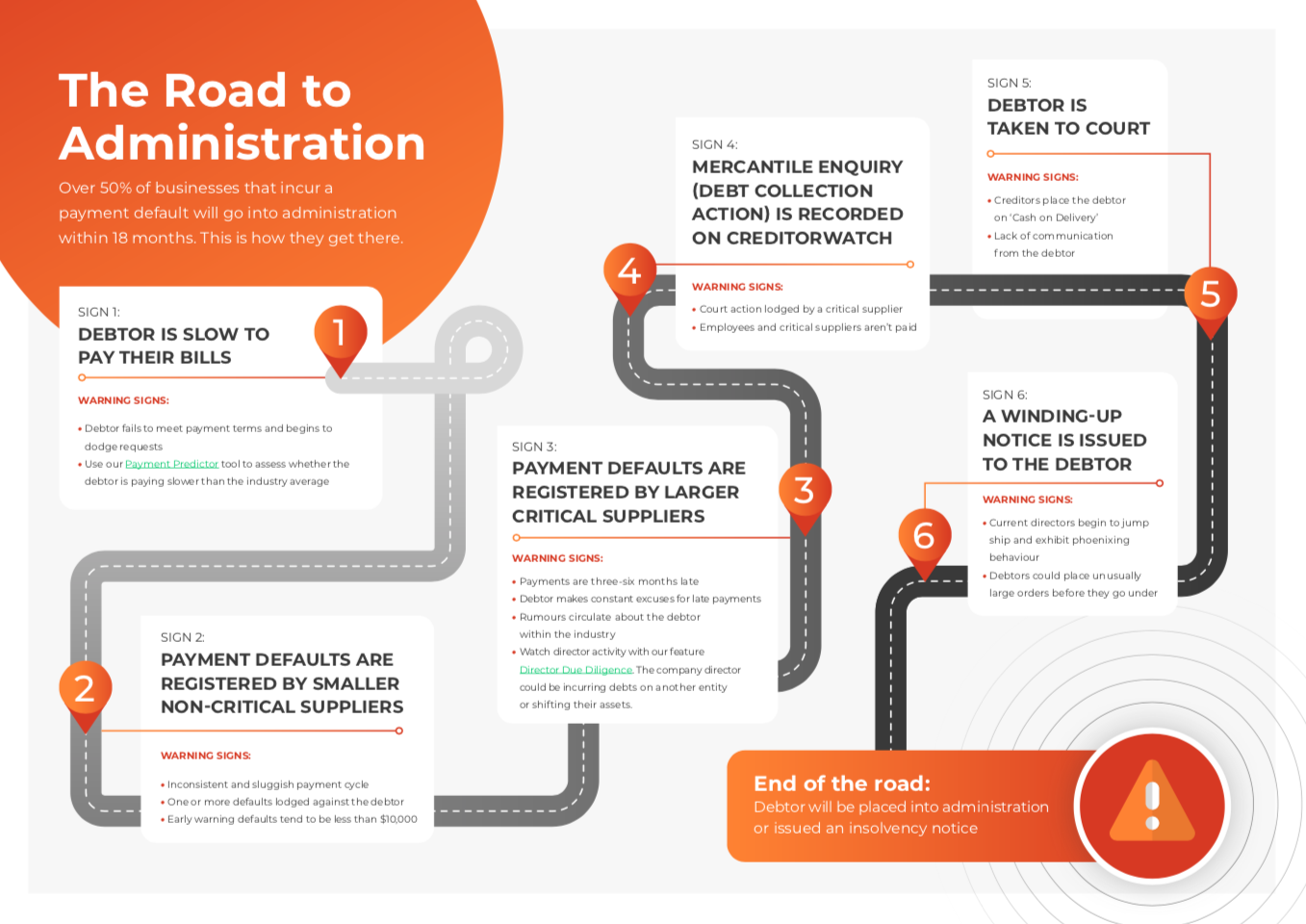Protect yourself from business credit risk
Across the country, small signs of stability are emerging in the SME sector. CreditorWatch’s data shows there was a slight decrease in payment times (7.6 per cent from June to July) and an uptick in credit enquiries being made (7.5 per cent from July to August) suggesting that SMEs are starting to get on top of their finances. It would be premature, however, to assume that these are the ‘green shoots’ of the Australian economy and that business credit risk doesn’t pose a problem.
The reality is that payment times remain high (up 291 per cent year-on-year in August) – a key indication that businesses are struggling with cash flow – and the number of companies entering into administration sits at the lowest number since 2016. Whilst apparently positive, this tells us that a significant number of businesses across the country are artificially supported by Government stimulus.
Australian businesses now face the tricky task of navigating the current economic climate and growing their customer base in a time of significant uncertainty. Given the thread by which many are hanging, the impact of a poor partnership could be devastating. So, as businesses begin to look forward, it begs the question – how do you know that a new customer can pay their bills and isn’t on the verge of collapse?
1. Know what constitutes a high-risk business
Unfortunately, there’s only so much you can understand about a business from what they tell you upfront, but there are warning signs that will paint an accurate picture of financial health:
- The debtor is slow to pay their bills
- Payment defaults are registered (by both smaller non-critical suppliers and larger suppliers)
- Debt collection action
- Court actions lodged
- Insolvency notices issued
There’s a path to insolvency that most businesses will follow – from payment defaults to administration – being notified of the warning signs will enable you to identify those risky customers and avoid extending lines of credit or goods/services that may never be settled. Click the image below to follow the signs along the road to administration
2. Explore the credit history of your customers
When you apply for personal credit, you’re required to submit to a credit history check and it’s now possible to demand the same from your commercial customers. In doing so, you essentially lift the hood of those businesses, gaining access to a hugely beneficial level of insight and creating some clarity in the current economic picture.
The process of running a business credit check takes mere minutes, and the outcome is an overview of the financial health and history of the company. Details like their ability to meet payment terms or historic issues with non-payment are immediately obvious and can guide your decision about whether or not to partner with them.
Understanding the details of a new customer’s credit history should be considered a mandatory part of customer onboarding.
3. Understand the business credit score
A credit score is essentially a one-stop-shop for knowing who to trade or partner with.
Beyond the information you can find, researching online, a company credit score aggregates data from sources like the Australian Securities and Investments Commission (ASIC), the Australian Business Register (ABR), Australian Financial Security Authority (AFSA), Australian Courts, mercantile agents (debt collectors) before classifying businesses into one of six categories of risk – from low to critical.
At a simple glance, it should be obvious to ascertain whether the customer is a suitable partner.
4. Get alerted to any changes in behaviour
If there’s one thing that’s been clear throughout 2020, it’s that change is inevitable. In a similar vein, business and credit reports are continually changing. It’s never been more important to stay on top of alerts and suspicious activity, as ultimately, it can be the difference between a paid or unpaid invoice or the success of your business.
Ongoing business credit monitoring – through proactive alerts – is the best way to manage a debtor. In doing so you’ll be able to identify the customers and businesses on the brink of collapse and take steps to prioritise debt collection or limit the credit line on offer.
Lower business credit risk and increase peace of mind
High payment times and a historic drop in the level of businesses entering into administration highlights the fact that behind the scenes, businesses are struggling. Australian businesses simply can’t afford any additional risk. What they need is to be able to get back to running their business, knowing that their customers have the means to pay their bills.
Taking steps to understand the financial health and history of new customers and partners could go a long way in protecting the bottom line of your business.
Matt Jackson
 Matt has over 12 years of experience in the credit industry and eight as the General Manager of CreditorWatch. Under Matt’s guidance, the CreditorWatch Sales and Account Management team has grown 100% year on year in both employee size and revenue.
Matt has over 12 years of experience in the credit industry and eight as the General Manager of CreditorWatch. Under Matt’s guidance, the CreditorWatch Sales and Account Management team has grown 100% year on year in both employee size and revenue.
Matt shares his knowledge, passion and enthusiasm with everyone he meets and has won multiple awards in the industry recognising his service. You can connect with Matt on LinkedIn or get in contact via matt.jackson@creditorwatch.com.au.




